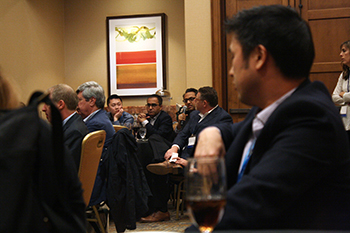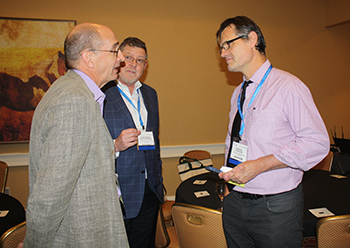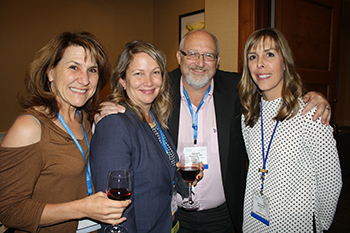CERN Supports Molecular Classification of Ependymoma Panel Discussion
— Categories: Press Release Posted on January 18, 2017
The 2016 Annual Meeting of the Society for Neuro-Oncology (SNO) was held from November 17-20 in Scottsdale, Arizona. During the meeting on Friday, November 18, the CERN Foundation supported a special evening session.
 This session focused on the new ependymoma classification guidelines published by the World Health Organization (WHO) in the recently revised Classification of Tumors of the Central Nervous System. The new system, that provides the classification of brain and spine tumors not only by their appearance under a microscope, but also based on their specific genetic signature, will likely have important implications for the future of ependymoma research and treatment.
This session focused on the new ependymoma classification guidelines published by the World Health Organization (WHO) in the recently revised Classification of Tumors of the Central Nervous System. The new system, that provides the classification of brain and spine tumors not only by their appearance under a microscope, but also based on their specific genetic signature, will likely have important implications for the future of ependymoma research and treatment.
This panel discussion was led by internationally recognized pathologists and neuro-oncologists who specialize in ependymoma including Drs. Kenneth Aldape, Michael Taylor, Mark Gilbert and Amar Gajjar. Over 30 CERN members, doctors, scientists and advocacy organizations (including members from the American Brain Tumor Association, National Brain Tumor Society and the Pediatric Brain Tumor Foundation) had an open and lively discussion of the utility and barriers to widespread adoption and use of the new classification system for ependymoma. The group engaged in an overview of the new guidelines for ependymoma, including a summary of the changes, asking "what does this mean for patients and how should doctors express these changes to patients"?
Recently, underlying genetic changes have revealed that ependymoma tumor subtypes may be different based on location. There are three locations thought to be important: those that are supratentorial, infratentorial (also called posterior fossa), and those located in the spinal cord. It was discovered that in approximately two-thirds of ependymomas in the supratentorial region, there is a molecular abnormality which is a gene fusion the C11orf95- RELA that results in a unique protein.
 The C11orf95- RELA fusion (or, “RELA fusion”) results in the uncontrolled activation of a specific tumor cell molecular pathway called the NF-kB pathway. NF-kB contributes to the formation of the tumor and its uncontrolled growth. The 2016 WHO classification recognizes that tumors that are RELA-fusion positive occur exclusively in the supratentorial region.
The C11orf95- RELA fusion (or, “RELA fusion”) results in the uncontrolled activation of a specific tumor cell molecular pathway called the NF-kB pathway. NF-kB contributes to the formation of the tumor and its uncontrolled growth. The 2016 WHO classification recognizes that tumors that are RELA-fusion positive occur exclusively in the supratentorial region.
If tumors are in the supratentorial region, it is recommended that the tumor is tested for the RELA-fusion by evaluating for a specific protein (for example LCAM-1) or the gene fusion itself by molecular techniques. Although doctors are still determining the best way to treat RELA-fusion positive patients, families may still prefer to know if they are more or less likely to be cured, similar to comparing a low-grade and high-grade tumor. “Anything that can help with the uncertainty,” shares Kim Wallgren, CERN Foundation president, on why this testing can improve patients well-being.
Posterior fossa (PF) ependymomas can also be divided based on molecular markers and are termed “PF-A” and “PF-B” molecular subtypes. These have different molecular origins and are, in turn, distinct from both spinal cord and supratentorial ependymomas. Recent information suggests the possibility to distinguish PF-A from PF-B tumors with techniques available in many hospital laboratories, but more work is required to conform these findings.
 CERN members also discussed the impact of changes on clinical trial designs and the importance of future ependymoma trials. We thank CERN members for their continuous support in helping the ependymoma community and we value the collaboration.
CERN members also discussed the impact of changes on clinical trial designs and the importance of future ependymoma trials. We thank CERN members for their continuous support in helping the ependymoma community and we value the collaboration.
Kim also announced an exciting development – the CERN Foundation will launch a second fellowship that will focus on ependymoma research named the Robert Connor Dawes fellowship, supported by the RCD Foundation that will launch in 2017-2018.
Recognizing that the ependymoma community is a savvy group and heavily involved in all aspects of this disease, CERN will continue to play an important role in communicating with ependymoma patients and bridging the gap between other advocacy groups, clinicians and patients.
